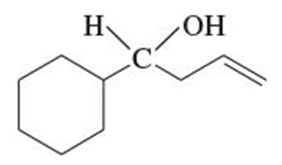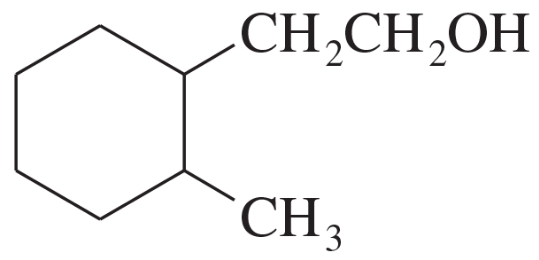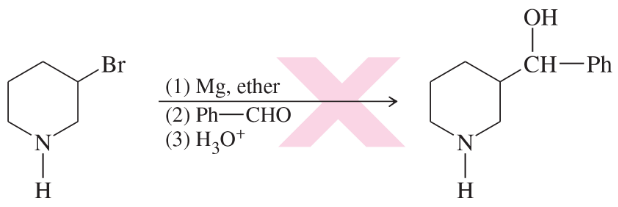 Back
BackProblem 14c
Show two ways you could synthesize each of the following secondary alcohol by adding an appropriate Grignard reagent to an aldehyde.
(c)
Problem 15b
Show how you would synthesize following tertiary alcohol by adding an appropriate Grignard reagent to a ketone.
b. Ph3COH
Problem 15c
Show how you would synthesize following tertiary alcohol by adding an appropriate Grignard reagent to a ketone.
c. 1-ethylcyclopentanol
Problem 15d
Show how you would synthesize following tertiary alcohol by adding an appropriate Grignard reagent to a ketone.
d. 2-cyclopentylpentan-2-ol
Problem 16
Propose a mechanism for the reaction of acetyl chloride with phenylmagnesium bromide to give 1,1-diphenylethanol.
Problem 17a
Show how you would add Grignard reagent to acid chloride or ester to synthesize the following alcohols.
a. Ph3C–OH
Problem 17c
Show how you would add Grignard reagent to acid chloride or ester to synthesize the following alcohols.
c. dicyclohexylphenylmethanol
Problem 18a
A formate ester, such as ethyl formate, reacts with an excess of a Grignard reagent to give (after protonation) secondary alcohols with two identical alkyl groups.
(a) Propose a mechanism to show how the reaction of ethyl formate with an excess of allylmagnesium bromide gives, after protonation, hepta-1,6-dien-4-ol.
Problem 18b
A formate ester, such as ethyl formate, reacts with an excess of a Grignard reagent to give (after protonation) secondary alcohols with two identical alkyl groups.
(b) Show how you would use reactions of Grignard reagents with ethyl formate to synthesize the following secondary alcohols.
(i) pentan-3-ol
(ii) diphenylmethanol
(iii) trans,trans-nona-2,7-dien-5-ol
Problem 19a
Show how you would synthesize the following alcohol by adding Grignard reagents to ethylene oxide.
(a) 2-phenylethanol
Problem 19c
Show how you would synthesize the following alcohol by adding Grignard reagents to ethylene oxide.
(c)
Problem 20a,b
Acetylide ions also add to ethylene oxide much like Grignard and organolithium reagents. Predict the products obtained by adding the following acetylide ions to ethylene oxide, followed by a dilute acid workup.
(a) HC≡C:–
(b) CH3CH2–C≡C:–
Problem 21a
Show how you would synthesize the following compound from alkyl halides, vinyl halides, and aryl halides containing no more than six carbon atoms.
(a) octane
Problem 21c
Show how you would synthesize the following compound from alkyl halides, vinyl halides, and aryl halides containing no more than six carbon atoms.
(c) trans-oct-3-ene
Problem 21d
Show how you would synthesize the following compound from alkyl halides, vinyl halides, and aryl halides containing no more than six carbon atoms.
(d) cyclopentyl propyl ketone
Problem 22a,b,c
Predict the products of the following reactions.
(a) sec-butylmagnesium iodide + D2O
(b) n-butyllithium + CH3CH2OH
(c) isobutylmagnesium bromide + but-1-yne
Problem 22d,e
Predict the products of the following reactions.
(d)
(e)
Problem 23a
Point out the flaws in the following incorrect Grignard syntheses.
(a)
Problem 23b
Point out the flaws in the following incorrect Grignard syntheses.
(b)
Problem 23c,d
Point out the flaws in the following incorrect Grignard syntheses.
(c)
(d)
Problem 24a
Predict the products you would expect from the reaction of NaBH4 with the following compounds. You may assume that these reactions take place in methanol as the solvent.
(a) CH3–(CH2)8–CHO
Problem 24c
Predict the products you would expect from the reaction of NaBH4 with the following compounds. You may assume that these reactions take place in methanol as the solvent.
(c) Ph-COOH
Problem 24d
Predict the products you would expect from the reaction of NaBH4 with the following compounds. You may assume that these reactions take place in methanol as the solvent.
(d)
Problem 24e
Predict the products you would expect from the reaction of NaBH4 with the following compounds. You may assume that these reactions take place in methanol as the solvent.
(e)
Problem 24f
Predict the products you would expect from the reaction of NaBH4 with the following compounds. You may assume that these reactions take place in methanol as the solvent.
(f)
Problem 25a
Predict the products you would expect from the reaction of LiAlH4 followed by hydrolysis with the following compounds. You may assume that these reactions take place in methanol as the solvent.
(a) CH3–(CH2)8–CHO
Problem 25c
Predict the products you would expect from the reaction of LiALH4 followed by hydrolysis with the following compounds. You may assume that these reactions take place in methanol as the solvent.
(c) Ph-COOH
Problem 25d
Predict the products you would expect from the reaction of LiAlH4 followed by hydrolysis with the following compounds. You may assume that these reactions take place in methanol as the solvent.
(d)
Problem 25e
Predict the products you would expect from the reaction of LiAlH4 followed by hydrolysis with the following compounds. You may assume that these reactions take place in methanol as the solvent.
(e)
Problem 26a
Show how you would synthesize the following alcohol by reducing appropriate carbonyl compound.
a. heptan-1-ol















